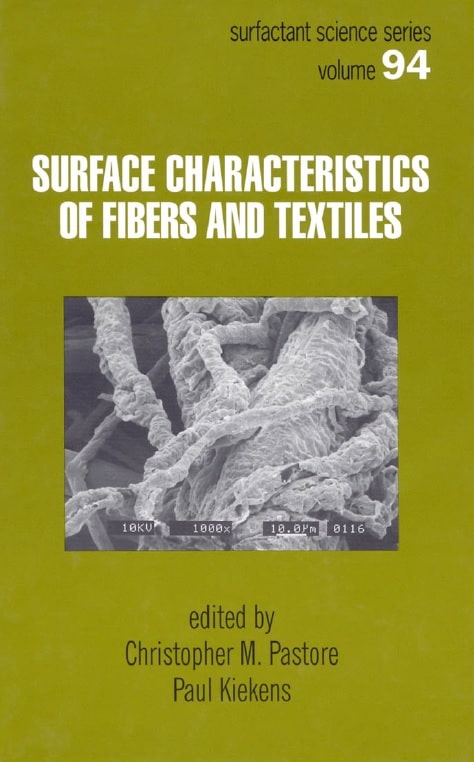
Contents
1. Formaldehyde-Free Durable Press Finishing 1
Cltrr-k M. Welch
2. Surface Characteristics of Polyester Fibers 33
YOLI-LOH sieh
3. Frictional Properties of Textile Materials S9
f2hlrlwrlrlc.r S. Guptcr
4. Infrared Absorption Characteristics of Fabrics 93
Wdlcrce W. Curr, Eli:crht~tk G. McFdcu1d. arlcl D. S. SNrrncr
5. Electrochemical Sensors for the Control of the Concentration of
Bleaching Agent to Optimize the Quality of Bleached and Dyed Textile
Products 123
Philippe WestDroek, Ecl~~arTdc ‘tnttlermcm, m d P a d Kiekerls
6. Surface Features of Mineral-Filled Polypropylene Filaments 139
Brian George, Sarmrel H I I ~ S OmH d, Marinn G. McCorcl
7. Inorganic Fibers I6 1
Allthorly R. Bunsell crtlrl Mtrrie-Hdi.ne Ber-ger
8. Surface Modification of Textiles by Plasma Treatments 203
Ce:ar-Dorv R ~ IPm, 1 Kiekms. and J o Versckur-en
9. Measuring Interface Strength in Composite Materials 219
Peter Schwcrrt:
1 0 . The Effect of Fiber Surface on the Thermal Properties of Fibrous
Composites 235
Yc1.ssc.r A. Gowayed
1 1. Design and Permeability Analysis of Porous Textile Composites Formed
by Surface Encapsulation 249
Mrrttkew Dwrn
Preface
This book reveals the expanding opportunities for fibers in a wide range of industrial applications. No longer limited to apparel and home furnishings, fibers are being used in medical devices, in aircraft components. and as intelligent sensors. For all these applications, the fiber surface plays an important and fundamental role.
The traditional textile industry needs to understand how fiber surface affects friction, dyeing, wrinkling, and other performance characteristitcos optimize production. Newly developing markets sucha s biomaterials, aerospace, andt he automotive industry are interested in more complex performance criteria such as permeability, stiffness, and strength. These properties are also governed to a large extent by the surface of the fiber. This should be no surprise because the high ratio of surface area to volume is a large part of what makes fibers unique. The topics addressed in this text range from commodity to innovation. The book begins with a discussion of the importance of fiber surface to the traditional textile industry. Following this, novel fibers and their applications are considered. The remainder of the book deals with the ability of fibers to function within composite materials.
The first chapter is, naturally enough, a discussion of cotton fibers-the stalwart of textile fibers. In this chapter, we learn about new techniques for developing wrinkle-resistant finishes on the surface of the fiber using environmentally friendly techniques. This is followed by a discussion of the surface characteristics of polyester tihers-a strong market competitor to cotton. These two chapters alone address the vast majority of textile fiber consumption. The next two chapters address fundamental issueso n the role of fiber surface. The frictional behavior of textiles is described in terms of the fiber surface proper ties in Chapter 3, and the infrared absorption characteristics (essential for environmental stability. rapid drying, and others) are addressed in Chapter 4.
New fibers and their applications are presented in the next three chapters. A new function for fiber surface is addressed in Chapter 5-the use of fibers as electrochemical sensors in bleaching operations. Chapter 6 discusses the properties of mineral-filled polypropylene fibers. Such fibers are of interest in biomedical applications such as bone plates. High-performance ceramic fibers are described in Chapter 7. These fibers, which are useful for high-temperature applications, typically have very high tensile moduli.
Plasma treatment of fibers is addressed in Chapter 8. Through plasma treatment operations it is possiblc to dramatically change the surface characteristics of fibers. One typical use is to make the fibers more chemically reactive for subsequent finishing treatments. This includes improving the bonding strength of fibers in resin.
The use of fibers in composite materials is discussed in the final three chapters. Chapter 9 addresses the role of the fiber-resin interface i n composites. The interfacial strength of the composite plays a significant role in the strength and damage tolerance of these advanced materials.
Chapter IO addresses the role of fiber surface on the thermal properties of composite materials. Chapter 1 1 presents a new concept in permeable composites. These materials may have traditionally been seen as inadequate for structural applications, but have function in interesting areas such as acoustic baffles in aircraft engines.
It is exciting to find so many different and exciting opportunities for fibers! In all the applications presented in this text, fiber surface plays an important role.
